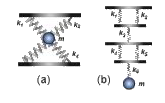Complete Solutions to EXAMPLE of chapter OSCILLATIONS of Class 11 book with complete answers and questions
| Class 11 | PHYSICS |
| Chapter | OSCILLATIONS |
| TAMILNADU GOVT | EXAMPLE |
| Number Of Questions | 22 |
| Academic Year | 2023-24 |
Classify the following motion as periodic and non-periodic motion?
Motion of Halley's comet.
View SolutionClassify the following motion as periodic and non-periodic motion?
Motion of clouds.
View SolutionClassify the following motion as periodic and non-periodic motion?
Moon revolving around the Earth.
View SolutionWhich of the following functions of time represent periodic and non-periodic motion?
a. sin `omega t` + cos `omega t`
b. ln `omega t`
View SolutionWhich of the following represent simple harmonic motion?
(i) x = A sin `omega t` + B cos `omega t`
(ii) x = A sin `omega t` + B cos `2omega t`
(iii) x = A `e^(i omega t)`
(iv) x A ln `omega t`
View SolutionConsider a particle undergoing simple harmonic motion. The velocity of the particle at position `x_1` is `v_1` and velocity of the particle at position `x_2` is `v_2`. Show that the ratio of time period and amplitude is
`(T)/(A)=2pi sqrt((x_2^2-x_(1)^2)/(v_(1)^2 x_2^2-v_2^2 x_(1)^2))`
View SolutionA nurse measured the average heart beats of a patient and reported to the doctor in terms of time period as 0.8 s. Express the heart beat of the patient in terms of number of beats measured per minute.
View SolutionCalculate the amplitude, angular frequency, frequency, time period and initial phase for the simple harmonic oscillation given below
`y=0.3 sin(40 pi t+1.1)`
View SolutionCalculate the amplitude, angular frequency, frequency, time period and initial phase for the simple harmonic oscillation given below
`y=2 cos(pi t)`
View SolutionCalculate the amplitude, angular frequency, frequency, time period and initial phase for the simple harmonic oscillation given below
`y=3 sin(2 pi t-1.5)`
View SolutionShow that for a simple harmonic motion, the phase difference between displacement and velocity is `pi/2` radian or `90^@`.
View SolutionShow that for a simple harmonic motion, the phase difference between velocity and acceleration is `pi/2` radian or `90^@`.
View SolutionShow that for a simple harmonic motion, the phase difference between displacement and acceleration is `pi` radian or `180^@`.
View SolutionA spring balance has a scale which ranges from 0 to 25 kg and the length of the scale is 0.25m. It is taken to an unknown planet X where the acceleration due to gravity is 11.5 `ms^(-1)`. Suppose a body of mass M kg is suspended in this spring and made to oscillate with a period of 0.50 s. Compute the gravitational force acting on the body.
View SolutionConsider two springs whose force constants are 1 N `m^(-1)` and 2 N `m^(-1)` which are connected in series. Calculate the effective spring constant (`k_s`) and comment on `k_s`.
View SolutionConsider two springs with force constants 1 N `m^(-1)` and 2 N `m^(-1)` connected in parallel. Calculate the effective spring constant (`k_p`) and comment on `k_p`.
View SolutionCalculate the equivalent spring constant for the following systems and also compute if all the spring constants are equal:

View SolutionA mass m moves with a speed v on a horizontal smooth surface and collides with a nearly massless spring whose spring constant is k. If the mass stops after collision, compute the maximum compression of the spring.
View SolutionIn simple pendulum experiment, we have used small angle approximation. Discuss the small angle approximation.
View SolutionIf the length of the simple pendulum is increased by 44% from its original length, calculate the percentage increase in time period of the pendulum.
View SolutionWrite down the kinetic energy and total energy expressions in terms of linear momentum, For one-dimensional case.
View SolutionCompute the position of an oscillating particle when its kinetic energy and potential energy are equal.
View Solution
EXAMPLE questions and complete solutions for chapter OSCILLATIONS of FULL MARKS PHYSICS(TAMIL) of Class 11